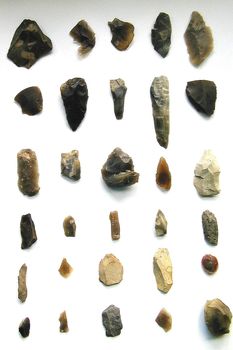Cecil Woodward Lithics Collection
Keith Boughey, 2020. https://doi.org/10.5284/1062888. How to cite using this DOI
Data copyright © Keith Boughey unless otherwise stated
This work is licensed under a Creative Commons Attribution 4.0 International License.
Primary contact
Keith
Boughey
Church Bank
Church Hill
Hall Cliffe
Baildon, W. Yorks
BD17 6NE
Resource identifiers
- ADS Collection: 3521
- DOI:https://doi.org/10.5284/1062888
- How to cite using this DOI
Introduction

The late Cecil Woodward, a resident of Shipley in West Yorkshire, was an amateur and entirely self-taught collector of prehistoric flints. Most of Woodward's flint collecting was done in the years immediately after the Second World War off the former river terraces of the River Aire at Charlestown, Baildon, West Yorkshire a few short miles from where he lived, at a time when they were just fields, still planted as they were during the War with potatoes and other vegetable crops. Since then they have been built on and the whole area, with the exception of a recently constructed nature reserve, is now a light industrial estate, so any archaeology is now irrecoverable.
The pieces were all found on or close to the surface, brought up by natural agents such as rainfall, erosion, the burrowing of worms and rabbits, and in particular as a result of ploughing. There was no excavation as such. They come in the main off the River Aire terraces, together with some from the northern edge of Rombalds Moor, the stretch of moorland in mid-Wharfedale above and to the East of Ilkley, West Yorkshire.
The collection currently resides in Shipley, West Yorkshire, which is where the depositor was able to see, identify, catalogue and photograph it. Nothing of this collection has ever been published, referred to or even hinted at in any published work. As with so many similar private lithics collections, the intention is to at least bring it into and secure it for the archaeological record which will add to and enhance our understanding of those areas in which the lithics were collected, which in turn should bring it to the attention of both the archaeological community and the wider public, and hopefully even see it or at least some part of it finally published.
The deposition of this archive was funded by the Yorkshire Archaeological & Historical Society and the Open Access Archaeology Fund.





